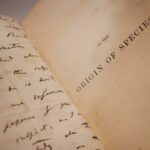Charles Darwin’s theory of evolution, underpinned by the concept of natural selection, has been a cornerstone of biological science since its inception in the 19th century. Understanding the creation of Darwin’s theory is not just a historical exercise, but also a way to appreciate the scientific method and the way it helps us make sense of the world around us.
The Early Life of Charles Darwin
Born in 1809, Charles Darwin hailed from a family with a strong scientific background. His grandfather, Erasmus Darwin, was a well-known botanist and a member of the Lunar Society, a group of intellectuals who were at the forefront of the Industrial Revolution in Britain. Charles Darwin’s own education at the University of Edinburgh and later at Cambridge University further nurtured his interest in natural history.
His mentors, such as botanist John Stevens Henslow and geologist Adam Sedgwick, played a crucial role in shaping Darwin’s scientific curiosity. These early influences, combined with his innate passion for nature, laid the groundwork for his revolutionary theory.
The Voyage of the Beagle
In 1831, Darwin embarked on a five-year voyage aboard the HMS Beagle. The voyage was intended to chart the coastline of South America, but for Darwin, it turned into a grand opportunity to study the natural world.
During the voyage, Darwin observed a variety of species and their adaptations to different environments. He noticed, for instance, that finches on different Galapagos Islands had different beak shapes, each suited to the specific diet available on their respective islands. These observations sparked the idea that species could change over time, adapting to their environments—a concept that would later form the basis of his theory of evolution.
Development of the Theory of Evolution
Darwin’s theory of evolution by natural selection is a simple yet powerful idea. It suggests that organisms best adapted to their environment are more likely to survive and reproduce, passing on their advantageous traits to their offspring. Over generations, these traits become more common within the population, leading to evolutionary change.
Darwin’s observations during the Beagle voyage, particularly the variations among similar species in different environments, led him to formulate this theory. He realized that such variations could not be explained by the then-prevailing belief in the immutability of species. Instead, he proposed that species evolve over time through the process of natural selection.
The Role of Fossils in Darwin’s Theory
Fossils played a significant role in the development of Darwin’s theory. During his travels, Darwin discovered fossils of extinct creatures that resembled living species, suggesting a link between the past and present life forms.
These fossils provided tangible evidence for the concept of evolution. They showed that life forms have changed over time, supporting Darwin’s idea of species’ transformation. Moreover, the discovery of transitional fossils, which exhibit traits of both ancestral and derived species, further substantiated the theory of evolution.
Darwin’s Theory and the Tree of Life
Darwin’s theory also introduced the concept of the ‘Tree of Life,’ a metaphorical representation of the relationships among all life forms on Earth. According to this concept, all living organisms share a common ancestor, from which they have diverged over time through the process of evolution.
The Tree of Life supports Darwin’s theory by illustrating how different species are related through common ancestry. It also highlights the diversity of life, which Darwin argued was a result of natural selection acting on heritable variations among individuals.
Controversies and Challenges to Darwin’s Theory
Despite its scientific merits, Darwin’s theory faced considerable opposition, particularly from religious quarters that saw it as contradicting the biblical account of creation. Even within the scientific community, some criticized the lack of a mechanism to explain how traits were passed from one generation to the next.
However, with the advent of genetics in the 20th century, the mechanism for inheritance was finally understood, bolstering the theory of evolution. Despite ongoing debates, Darwin’s theory remains a fundamental principle in biology, its validity supported by a wealth of evidence from various scientific disciplines.
The Legacy of Darwin’s Theory
Darwin’s theory has had a profound impact on biological and genetic research. It has provided a framework for understanding the diversity of life and has influenced fields as diverse as medicine, psychology, and ecology.
Moreover, Darwin’s theory has reshaped our understanding of human evolution, highlighting our kinship with all other life forms on Earth. It has challenged our perceptions of ourselves and our place in the natural world, making it one of the most influential ideas in human history.
Conclusion
In unraveling the origins of Darwin’s theory, we gain insight into the workings of science and the power of observation and critical thinking. Darwin’s theory was created not in isolation but through a process of careful observation, reflection, and synthesis of ideas. Its enduring relevance underscores the importance of scientific inquiry in enhancing our understanding of the world.
Frequently Asked Questions
What is Darwin’s theory of evolution?
Darwin’s theory of evolution suggests that species evolve over time through the process of natural selection, where organisms best adapted to their environment are more likely to survive and reproduce.
What influenced Darwin’s creation of his theory?
Darwin’s theory was influenced by his observations during the Beagle voyage, his study of fossils, and his background in natural history.
What is the Tree of Life in Darwin’s theory?
The Tree of Life is a metaphorical representation of the relationships among all life forms on Earth, illustrating how different species are related through common ancestry.
What were the initial reactions to Darwin’s theory?
Darwin’s theory faced considerable opposition, particularly from religious quarters. Some scientists also criticized the lack of a mechanism to explain how traits were passed from one generation to the next.
How has Darwin’s theory impacted scientific research?
Darwin’s theory has provided a framework for understanding the diversity of life and has influenced various fields, including medicine, psychology, and ecology.
Why is Darwin’s theory still relevant today?
Darwin’s theory remains a fundamental principle in biology, its validity supported by a wealth of evidence from various scientific disciplines. It continues to guide research and shape our understanding of life on Earth.
References:
- Darwin, C. (1859). On the Origin of Species by Means of Natural Selection, or the Preservation of Favoured Races in the Struggle for Life. London: John Murray.
- Browne, E. (2002). Charles Darwin: The Power of Place. Princeton University Press.
- Coyne, J. A. (2009). Why Evolution is True. Viking.
- Ridley, M. (2004). Evolution (3rd ed.). Blackwell Publishing.
- Mayr, E. (2001). What Evolution Is. Basic Books.








